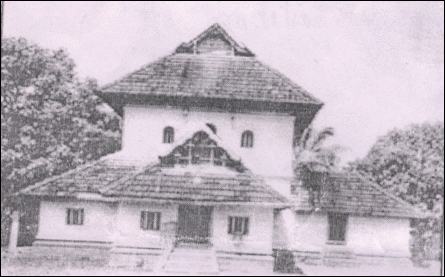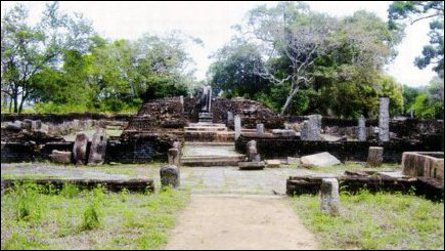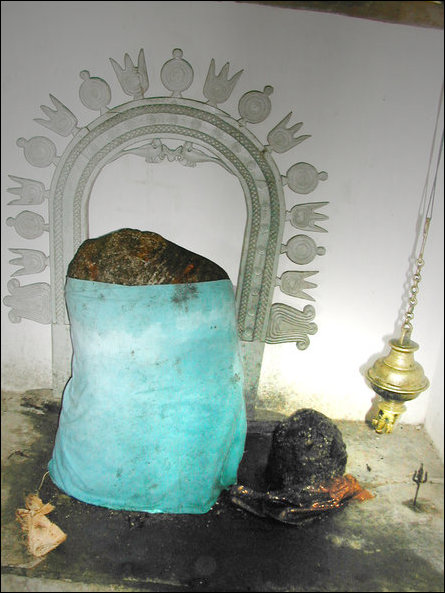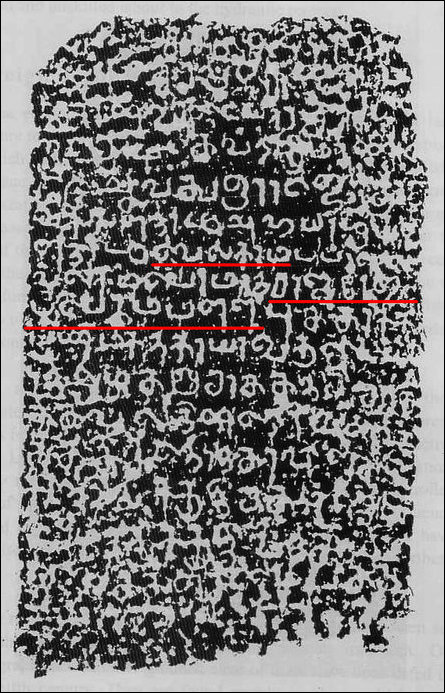|
|
Know the Etymology: 58
Place Name of the Day: Thursday, 15 June 2017
Paḷḷi-vācal-veḷi, Kākkāk-paḷḷi, Pallik-kuḍāva, Palliya-koṭuva, Paḷḷik-kuṭiyiruppu, Paccilaip-paḷḷi, Paḷḷi-māl, Kīrip-palli, Pallai-tīvu
பள்ளிவாசல்வெளி, காக்காப்பள்ளி, பல்லிக்குடா₃வ, பல்லிய-கொ[ட்]டுவ, பள்ளிக்குடியிருப்பு, பச்சிலைப்பள்ளி, பள்ளிமால், கீரிப்பல்லி, பல்லைதீவு
Paḷḷi-vācal-veḷi, Kākkāk-paḷḷi, Pallik-kuḍāva, Palliya-koṭuva, Paḷḷik-kuṭiyiruppu, Paccilaip-paḷḷi, Paḷḷi-māl, Kīrip-palli, Pallai-tīvuPaḷḷi+vācal+veḷi
Kākkā+paḷḷi
Palli+kuḍāva
Palliya+koṭuva
Paḷḷi+kuṭiyiruppu
Paccilai+paḷḷi
Paḷḷi+māl
Kīri+palli
Pallai+tīvu
The expanse of the mosque
The Muslim mosque or the elder brother's mosque
The bay or cove having a mosque on its shore
The mosque enclosure; or the enclosure of the place of worship
The cattle-pen settlement or the settlement of cattle herders
The cattle-pen or the hamlet of cattle herders in the locality of Paccilai trees; or the place of worship in the locality of Paccilai trees
The cattle-pen shed
The cattle-pen or the hamlet of cattle herders in the locality of Kīri shrubs
The cattle-pen islet; or the grazing-land islet
| Paḷḷi1 | mosque (Eezham Tamil usage and place names; a meaning commonly seen in Tamil, Tulu and Malayalam usages, DED 4018; seen as Faḷḷi in Dhivehi/ Maldivian, DBF; early usage in this meaning seen in Ainūṭṭuva-perum-balli, Tamil/ Telugu inscription, 1090 CE, Subbarayalu, 2012, pp 183-186: Añcuvaṇṇap-paḷḷi, inscription c. 13th century CE); Christian church (Tamil, inscription, 849 CE, TAS, ii, p. 67-68; MTL Appendix; Malayalam, DED 4018); Jewish synagogue (Malayalam, Subbarayalu, 2012, p. 186); Buddhist temple/ monastery (Tamil, Maṇimēkalai, 28: 70-72; inscription, 1008 CE, EI, xxii, 34; Eezham Tamil, Velgam Vehera inscription, 11th century CE, Indrapala, 2006, plate 27; Malayalam, DED 4018); Jain or Buddhist temple/ monastery (Tamil, Cilappatikāram, 5: 179; DED 4018); Jain temple/ monastery (Tamil, inscription, c. 550 CE, TASSI, 1958-59, pp. 41-83; DED 4018); Jain hermitage, cave or rock shelter where stone beds are prepared for Jaina monks to sleep (Tamil, Brahmi inscriptions, c. 2nd century CE, ETE, 2003, 88; DED 4018); sleep, sleeping, bed, residence, nest (Tamil, Caṅkam diction, Kuṟuntokai, 142: 4-5; Narṟiṇai, 195: 3; Akanāṉūṟu, 93: 14; Kuṟuntokai, 46: 2-5, Maturaikkāñci, 169-170; DED 4018); burial place, as in Paḷḷi-paṭutta-iṭam (Tamil, inscription, 877 CE, EI, vii, 26a); burial monument, as in Paḷḷip-paṭai (Tamil, inscription, 941 CE, SII, viii, 529); royal seat as in Paḷḷik-kaṭṭil, couch, hall, terrace, room, shed, school (Tamil, inscription, 798 CE, SII, xii, 39; Cilappatikāram, 4: 60; 25: 14; Peruṅkatai, 38: 245; Tirumaṅkaiyāḻvār; DED 4018); Vaishnava or Saiva temple where the deity is found in a sleeping posture, as in Curuṭṭap-paḷḷi (Tamil Nadu place name); Paḷi, Paḷi-i, Paḷi-iy, Paḷi-y: = Paḷḷi: Jain hermitage, sleeping place, cave shelter with stone beds (Tamil Brahmi inscriptions, c. 3rd -2nd century BCE to 2nd century CE, ETE, 2003, 1, 2, 10, 15, 52, 59, 65, 89); Paḷḷiru: (verb) to rest, inhabit (Kannada, DED 4018); Paṭu: (verb) to lie down to sleep (Tamil, DED 3852). See Paḷḷi 2 |
| Paḷḷi2 | place or settlement where cattle are kept, village of cattle herders (Eezham Tamil usage, especially Eastern Province; Tamil, Caṅkam diction, Akanāṉūṟu, 107: 8; DED 4018); hamlet (Tamil, Tivākaram, 5: 103; DED 4018); location, place (Tamil, MTL, Tolkāppiyam, Eḻuttu, 100); hut, small settlement of jungle tribes (Malayalam, DED 4018); Paḷḷi, Haḷḷi: settlement, abode, hamlet, village (Kannada, DED 4018); Haḷḷi: hamlet, small village (Tulu, DED 4018); Paḷḷi, Palli: village, hut (Telugu, DED 4018); Palliya, Palle: small village (Telugu, DED 4018); Pallī: small village, hut (Sanskrit, etymology traced to Tamil/ Dravidian, CDIAL 7972); Palli: small village (Prakrit, CDIAL 7972, see Pallī); Pẹla: hut, shed; "Kuṭiya, Kuḍā gēya" (Sinhala, Sorata). Paḷḷiru: (verb) to rest, inhabit (Kannada, DED 4018); Paṭu: (verb) to lie down to sleep (Tamil, DED 3852); Paṭṭam: sleeping place for animals (Tamil, DED 3868); Paṭṭi: cattle-pen, cow-stall, sheepfold, hamlet, village (Tamil, DED 3868, note the Ṭ/ Ḷ interchange Paṭṭi/ Paḷḷi). See Paḷḷi 1 |
| Paḷḷivācal | mosque (Tamil, MTL); Paḷḷi+vācal; Paḷḷi: see Paḷḷi 1; Vācal: doorway, entrance, place (Tamil, DED 5354). See column 192 |
| Palli1 | also Palliya: (Sinhala) mosque (place names); small village, city, chapel, church, place of Christian worship, school, schoolroom (Sinhala, Clough); school, temple, place of worship, "Pāṭhaśālāva, Devasthānaya, Pūjyasthānaya" (Sinhala, Sorata); Alliya: spot, place, a place or square on a chess board, a small Hindu temple under a tree etc. (Sinhala, Clough); Faḷḷi: mosque (Dhivehi/ Maldivian, DBF). See Paḷḷi 1 and Paḷḷi 2 |
| Palli2 | (Eezham Tamil) seems to be a variation of Paḷḷi, meaning a cattle station, hamlet of cattle herders or hamlet (place names, as in Kīrip-palli); Palliya, Palle: small village (Telugu, DED 4018). See Paḷḷi 2 |
| Pallai | also Pallu: (adjective) seems to be meaning a cattle-herding station or grazing land (place names especially in Jaffna, as in Pallai-tīvu, Pallup-pai etc.). See Paḷḷi 2 and Palli 2 |
| Paccilai | 1. A tree, Mysore gamboge, Garcinia xanthochymus, Xanthochymus pictorius (Tamil, DED 3832, listed under trees in Piṅkalam 2739, cognates in Malayalam and Kannada); = Tamālam: (Tamil, Piṅkalam 2739); Tamāla: Xanthochymus pictorius (Sanskrit, CDIAL 5690); = Pacumpiṭi: Mysore gamboge (Tamil, Piṅkalam 3832, Patiṟṟuppattu, 81: 25, MTL); 2. A fragrant creeper called Paccilai and Tamālam (Tamil, MTL, Naṟṟiṇai, 292: 2); 3. A tree, Dalbergia paniculata (Tamil, MTL); 4. Leaves used as herbal medicine (Tamil, MTL); all usages come from lush green leaves, DED 3821+497; Paca: (verb) to be green (Tamil, DED 3821); Pacu: green (Tamil, DED 3821); Ilai: leaf (Tamil, DED 497) |
| Kākkā | 1. A term used by Tamil Muslims to refer or address an elder brother or a senior person (Tamil Muslim usage, MTL); 2. A term of identity used by non-Muslims to refer to a Muslim man (Eezham Tamil usage); the latter is a given identity that probably comes from the frequent use of the term by Tamil Muslims or from noting the brotherhood concept in Islam; Kākā: elder brother (Urdu, MTL); Kākka: senior male relative (Sanskrit, cognates in 15 IA and tribal languages, CDIAL 2998 traces etymology to Dravidian); Kakka: uncle (Kannada, cited by CDIAL 2998); daddy (Telugu, cited by CDIAL 2998); Kākke: maternal uncle (Malayalam, cited by CDIAL 2998); note Tampi meaning younger brother in Tamil (DED 3085) being a term referring to a Muslim in Sinhala (Tambi: "Marakkala minisā," Sorata) |
| Māl | shed, shed to keep cattle (Eezham Tamil, related to DED 4796). See column 190 |
| Kuḍāva | toponymic cognate of Kuṭā in Tamil, meaning a bay or cove (DED 2054). See column 59 |
| Kuṭiyiruppu | settlement (Tamil, DED 1655+480). See column 52 |
| Koṭuva | enclosure (Sinhala, Clough). See columns 237, 290 |
| Kīri | a shrub, Pembhis acidula, in coastal place names and acacia in interior place names (See column 19) |
| Tīvu | island, islet (See column 32) |
In Eezham Tamil place names, the component Paḷḷi is used in two shades of meanings: it means a mosque and it also means a cattle station or a hamlet of cattle herders, especially in the Eastern Province. In old Eezham Tamil usage, Paḷḷi was meaning a Buddhist temple cum monastery, as testified by the Velgam Vehera Tamil inscriptions of 11th century CE. The Sinhala cognate Palli/ Palliya means a mosque as seen in place names, while it also means a church or a place of worship. Palli and Pallai, noticed in some Eezham Tamil place names in the North, seems to be variations of Paḷḷi in the meaning of cattle-pen or hamlet. Probably there is Telugu influence in these word forms. The terms and the shades of meanings are related in their etymological origins and are traced to Dravidian (DED 4018). Paḷḷi originally meaning a place to sleep, became a term meaning a Jaina hermitage or Buddhist monastery, and then came to mean places of worship especially belonging to heterodox religions. From the same original meaning, i.e, place to sleep, Paḷḷi came to mean a cattle station, hamlet of cattle herders or a hamlet/ village in general. See boxes on Paḷḷi 1 and Paḷḷi 2, and the old usage examples below. * * *Paḷḷi meaning sleep, sleeping and bed:"நீர்நாய்…தில்லை அம் பொதும்பில் பள்ளி கொள்ளும்" (நற்றிணை, 195: 3) "Nīrnāy…tillai am potumpil paḷḷi koḷḷum" (Naṟṟiṇai, 195: 3) The otter (of the backwaters) would sleep/ take bed in the tree-hole of Tillai tree [a salt marsh tree, Excoecaria agallocha]
"நுரை முகந்தன்ன மென் பூச் சேக்கை நிவந்த பள்ளி" (அகநானூறு, 93: 13-14) "Nurai mukantaṉṉa meṉ pūc cēkkai nivanta paḷḷi" (Akanāṉūṟu, 93: 13-14) The high Paḷḷi (bed), having a mattress so soft and fine as though it is stuffed with foam
Paḷḷi meaning cave shelter where beds are cut in stone to serve as hermitage of Jaina monks:"சேக்கந்தண்ணி செயிவித்த பள்ளி" (Tamil Brahmi inscription, ETE 2003, 83) "Cēkkantaṇṇi ceyivitta paḷḷi" (Tamil Brahmi inscription, ETE 2003, 83) The Jaina hermitage (cave shelter where beds are cut in stone), was caused to be made by Cēkkanti Aṇṇi [a lady devotee]
Paḷḷi meaning monastery resided by Buddhist monks:"இந்திர விகாரமென எழில் பெற்று நவையறு நாதன் நல்லறம் பகர்வோர் உறையும் பள்ளி" (மணிமேகலை, 28: 70-72) "Intira vikārameṉa eḻil peṟṟu navaiyaṟu nātaṉ nallaṟam pakarvōr uṟaiyum paḷḷi" (Maṇimēkalai, 28: 70-72) The Paḷḷi (Buddhist monastery in Kāñci), beautiful like the Intira Vikāram monastery (in Kāvirippūm-paṭṭiṉam), where monks who preach the good Dharma of the sorrow-exterminating Lord (Buddha) reside
Paḷḷi meaning early Christian church:"தருஸாப் பள்ளிக்கு ஐயனடிகடிருவடி குடுத்த வீடுபேறாவது" (Tamil inscription, 849 CE, TAS, ii, p. 67-68) "Tarusāp paḷḷikku Aiyaṉaṭikaṭiruvaṭi kuṭutta vīṭupēṟāvatu" (Tamil inscription, 849 CE, TAS, ii, p. 67-68) The rights and privileges given to the Tarusāp Paḷḷi (Christian church) by Aiyaṉ-aṭikaḷ-tiruvaṭi (ruler of Vēṇāṭu, i.e., today's Kollam region of Kerala) * * *Paḷḷi meaning cattle station or hamlet of cattle herders:"ஆன் நிலைப் பள்ளி அளை பெய்து அட்ட" (அகநானூறு, 107: 8) "Āṉ nilaip paḷḷi aḷai peytu aṭṭa" (Akanāṉūṟu, 107: 8) (The rice) cooked with curds coming from the cattle station or hamlet stationing cattle
Paḷḷi meaning small village:"பட்டும் நொச்சியும் பள்ளியும் சிற்றூர்" (திவாகரம், 5: 103) "Paṭṭum nocciyum paḷḷiyum ciṟṟūr" (Tivākaram, 5: 103) Paṭṭu, Nocci and Paḷḷi mean a small village * * *Paccilai meaning the tree, Garcinia xanthochymus (Mysore gamboge):"பச்சிலை தமாலம் பசும்பிடியாகும்" (பிங்கலம், 2739) "Paccilai tamālam pacumpiṭiyākum" (Piṅkalam, 2739) Paccilai and Tamālam are names of Pacumpiṭi [all are identified with the tree, Mysore gamboge] * * *Paḷḷi-vācal-veḷi is in Vēppaṅkuḷam in Musali division of Mannar district. Kākkā-paḷḷi is in Chilapam division of Puttalam district. Pallik-kuḍāva is a place in Tangalle division of Hampantota district. There is a cove at this coastal place and the adjacent village is called Marakkala-goḍa, meaning the Muslim village. Note the Tamil place name Paḷḷik-kuṭā in Pūnakari. Palliya-koṭuva is in Pujapitiya division of Kandy district. Paḷḷik-kuṭiyiruppu is noticed as a place name in Moothoor division of Trincomalee district and in Akkaraippattu division of Amparai district. Paccilaip-paḷḷi is a place as well as the name of a division in Kilinochchi district. It is one of the traditional divisions of Jaffna Peninsula. Periya Paccilaip-paḷḷi in the division is probably the original place of the toponym. Paḷḷi-māl is a locality in Kuppiḻāṉ in Valikamam South division of Jaffna district (Balasundaram, p. 353). Kīrip-palli is a locality near Navuṇṭil in Vadamaratchi Southwest division of Jaffna district. Pallai-tīvu is an uninhabited grassland islet adjacent to Puṅkuṭitīvu Island in Kayts division of Jaffna district (Delft OIS) * * *Some related place names:Paḷḷi:Periya-paccilaipp-paḷḷi: Pachchilaippalli, Kilinochchi Paḷḷi-muṉai: Mannar Town, Mannar. The place has a mosque Paḷḷik-kuṭā: Poonakary, Kilinochchi. Kuṭā: bay, cove. The place has a mosque (Pooneryn OIS) Māvaṭip-paḷḷi: Karaitheevu, Amparai Kāṭṭup-paḷḷi-veṭṭai: Eravur, Batticaloa. Veṭṭai: open place, expanse. The place has a mosque where Muslim burials take place; Kāṭu: Iṭu-kāṭu, Paṭu-kāṭu: burial place (Tamil, DED 442+1438; DED 3852+1438) Ōṭṭup-paḷḷi-veṭṭai: Eravur, Batticaloa. Veṭṭai: open place, expanse. The place has a mosque Periya-paḷḷik-kuṭiyiruppu: Puttalam, Puttalam Paḷḷi-vācal-pāṭu: Munthal, Puttalam. Pāṭu: beach for seine fishing Paḷḷit-tiṭal: Medirigiriya, Polonnaruwa (OIS). The place called Palliya-goḍẹlla in Sinhala has a mosque as well as a grazing land * * *Palli, Palliya: (Sinhala) Palliya-piṭiya: Divulapitiya, Gampaha; Hikkaduwa, Galle Palliya-vatta: Kalpitti, Puttalam; Wattala, Gampaha Palli-mulla: Panadura, Kalutara Palli-maňkaḍa: Panadura, Kalutara Paraṇa-jummā-palli: Puttalam, Puttalam. Paraṇa: old Palliya-goḍẹlla: Medirigiriya, Polonnaruwa. See Paḷḷit-tiṭal Palli-pōruva: Mawanella, Kegalle. Pōruva: = Pēruve: part, division * * * Tamil Brahmi inscription at Mannaar Koayil, Tamil Nadu, which records the making of a Jaina Pa'l'li (hermitage). [Image and text courtesy: I. Mahadevan, Tamil Brahmi Inscriptions]
 The Chearamaan Pa'l'li (mosque) at Kodungkoa'loor (Thiruvangnchaikka'lam, Kerala), believed to have been built in 629 CE. The bodies of some of the original followers of the Prophet are said to be buried here. This mosque doesn't face towards Makka, but faces towards east like Hindu temples. Entry is allowed for people of all religions into this mosque. [Courtesy: Indian Public Domain Photographs, Wikipedia]
 Velgam Vehara or Raja Raja Perumpa'l'li, situated 15 km northwest of Trincomalee off the Trinomalee - Horawapothana Road. Also known as Naathanaar Koayil, the temple, probably of Mahayana sect, is an important evidence for the prevalence of Tamil Buddhism in Sri Lanka. [Courtesy: K. Indrapala, The Evolution of an Ethnic Identity]
 A headless image of Buddha, made of limestone, is worshipped as Aiyanaar at Paalaavikku'lam, facing Pa'l'likkudaa Bay. The image is blackened by the application of oil. A close look may reveal the drapery on the left shoulder of the image. [Photo- Antony Richard, Ki'linochchi]
 One of the many Tamil inscriptions of the Chola times found at Velgam Vehera. Note the place names Velakaama and Raaja Raajap Perum Pa'l'li, underlined in red. [Courtesy: K. Indrapala, The Evolution of an Ethnic Identity.]
 The Pachchilai tree: Garcinia xanthochymus [Photo: Paul Latham]
 Pachchilai (Garcinia xanthochymus): unripe fruit [Courtesy: arbolesornamentales.com]
 Ripe fruit of Pachchilai (Garcinia xanthochymus) [Courtesy: sunfield.ne.jp]
Previous columns:
|
|














